If your Mac is low on storage it can cause problems – you might see a message that your start-up disk is almost full, for example, and if you ignore that you might find you can’t even start up your Mac! Low storage can also slow your Mac right down and cause other issues stopping it from running at its best.
If you are struggling with not enough storage on your Mac you might be wondering what you can delete. Apple offers ways to make this process easy (read how to make more space on your Mac). If you click on the Apple logo > About This Mac and choose Storage you will see a diagram like this one:
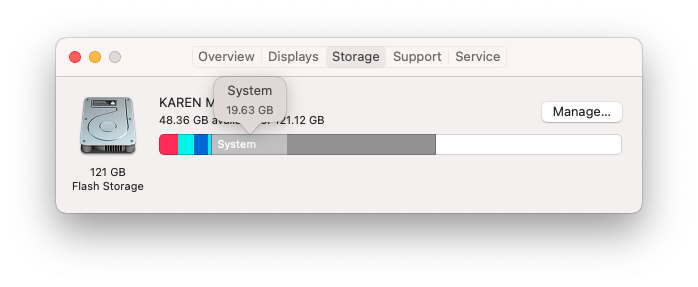
This graph indicates how much of your storage is attributed to certain types of files on your Mac. As you can see from the image above: System is using up 19.63GB on our Mac. We’ve heard of people with much much more space being sttributed to System though.
However much space System is taking up, if storage space is limited you will be looking for ways to reduce it. So, what is System, what types of files lurk there, and how can you reclaim the space it’s occupying?
What is in System?
System is something of a catch-all title for various elements that are spread across your Mac’s drive. These usually include old Time Machine snapshots, iOS backups, cache files, any downloaded disc images for upgrading apps or macOS, and if you’ve enabled the FileVault encryption feature then its files will also appear in System.
How much space is System taking up?
To get an idea of the space being used by System files, take the following steps:
- Click on the Apple logo in the upper left corner of the screen
- Select About this Mac.
- On the small window that appears, click the Storage tab
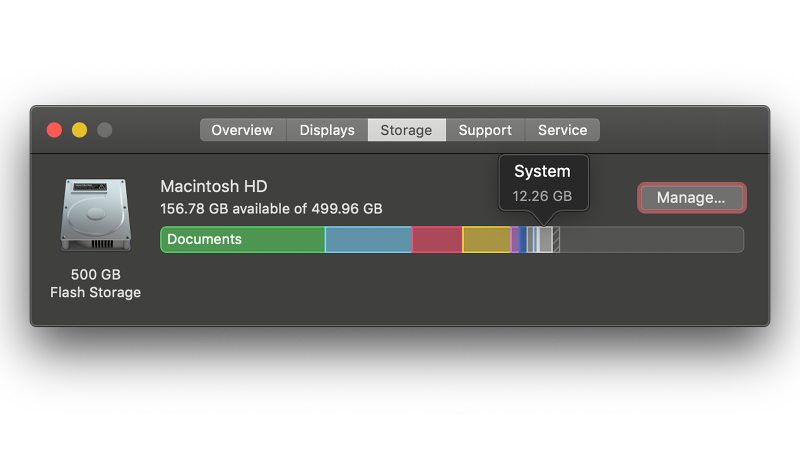
You’ll see a graphic illustrating how the space on your disk is being allocated. System is grey and if you hover the mouse cursor over the area it will reveal the size. For a more detailed breakdown, click the Manage… button, which opens a new window with the various elements listed, along with the storage space they’re using.
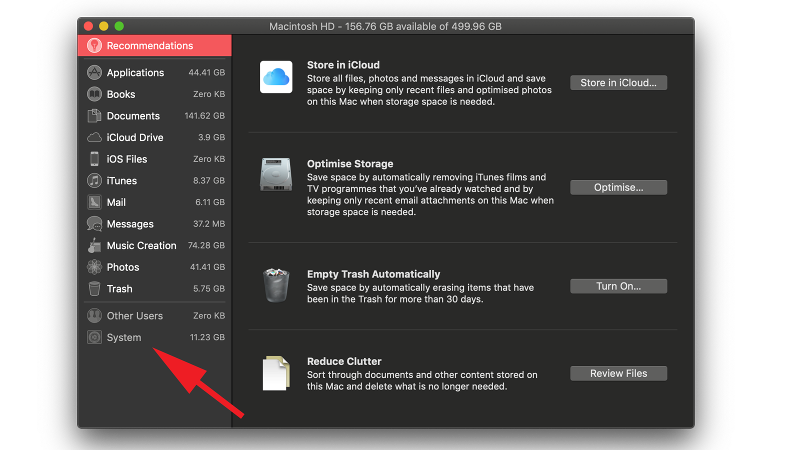
You’ll find System at the bottom but, unlike the rest of the list, clicking on it will not reveal which files are being attributed to System. This means you’re on your own when it comes to clearing it out.
If you see another section called Other taking up disk space, then you’ll need to deal with this as well. We outline the steps you’ll need to take in how to delete Other storage on Mac.
Why is System on my Mac so high?
It all depends on which files are on your Mac. If you have a lot of Time Machine or iOS backups, then these can often be the cause of a large build up in System.
When you fire up the Storage over view in About This Mac it’s worth waiting a few minutes before concluding that System is taking up an obscene amount of storage. Apparently it can readjust itself after a few minutes when some things that were attributed to System are relocated to iCloud or elsewhere (although that didn’t happen in our case unfortunately).
Can I delete System on my Mac?
There is no Clear System or Delete System button available in macOS, so you’ll have to manage the storage yourself. In the sections below we will explain how to delete each type of System file.
Alternatively you could opt for a system clean-up app like MacPaw’s CleanMyMac X or Nektony’s MacCleaner Pro. You can find reviews of those tools, along with several more in our roundup of the best Mac cleaner software and optimisation utilities.
While it’s possible to manually delete the various files included in the System category, we’d recommend only do so if you’re confident you know what you’re doing. It’s easy to accidentally delete an important file, only to discover it causes problems later on. If disaster does strike, try some of the tips in how to recover deleted files on Mac.
Before removing anything at all, we’d suggest running a full backup of your Mac’s storage, just so you can return it to the previous state if any problems arise. Read how to backup a Mac and best Mac backup software for more details.
How to remove Time Machine snapshots on Mac
One of the main culprits for taking up space in System is the local snapshots Time Machine creates each day. You might think that Time Machine backups are only saved to an external disk, but Apple also creates local snapshots on your startup volume. The company says that these snapshots will only be saved if there is plenty of free space and old snapshots will automatically be deleted when new ones are made.
This is great if you accidentally save in correct changes to a document, or delete something you didn’t mean to, but it can take up space on your Mac that you might prefer to have access to.
Luckily there is an easy methods for removing local snapshots from your hard drive. You can simply turn off the Time Machine feature itself, which will remove all of the local snapshots stored on your Mac. There is also a slightly more complicated method using Terminal. We explain both in our step-by-step guide for removing these space-stealing artefacts, so read how to delete Time Machine backups on Mac to find the easy way to remove them.
How to remove old iOS backups on Mac
Another hogger of System space is old backups of your iPhone or iPad. These can use up unnecessary space on your Mac, so it’s a good idea to clear them out once in a while. Depending on which version of macOS you’re using, here’s how to quickly dispense with them.
macOS Catalina or later
- Open Finder
- Click on your iPhone in the left-hand menu
- Select Manage Backups…
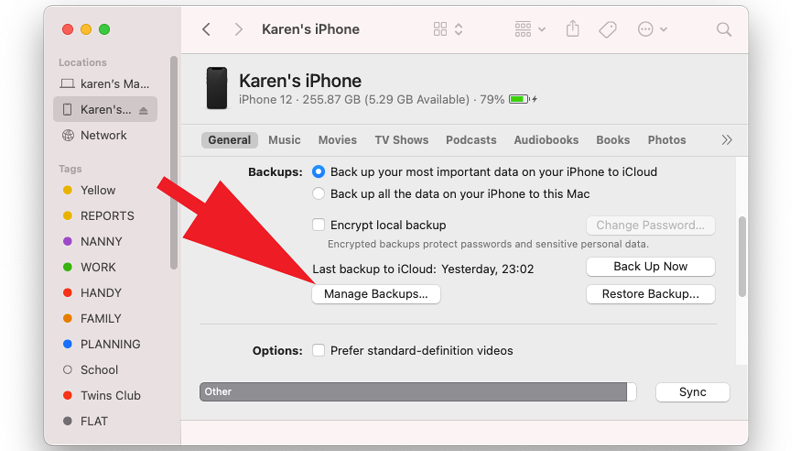
- Highlight the ones you no longer need
- Click Delete Backup then confirm your choice
macOS Mojave or earlier
- Open iTunes
- Select iTunes (in the top left corner) then Preferences
- Choose the Devices tab from the window that appears
- Highlight the backups you no longer need
- Click Delete backup
How to find the System folder on Mac
That’s taken care of two of the biggest users of System storage on the Mac, what about everything else?
macOS likes to keep the System and Library folder hidden, presumably to prevent users from accidentally moving or deleting essential files. But if you want to access that part of your storage, then it’s possible via a menu option in Finder.
To grant yourself temporary access, use the following steps:
- Open a new Finder window
- Go to your Home folder (press Command + Shift + H)
- Right click and choose Show View Options from the menu
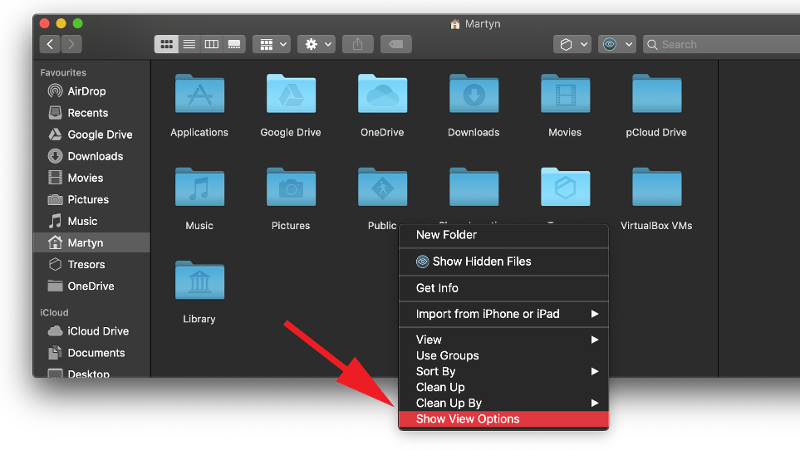
- Enable the option to Show Library Folder
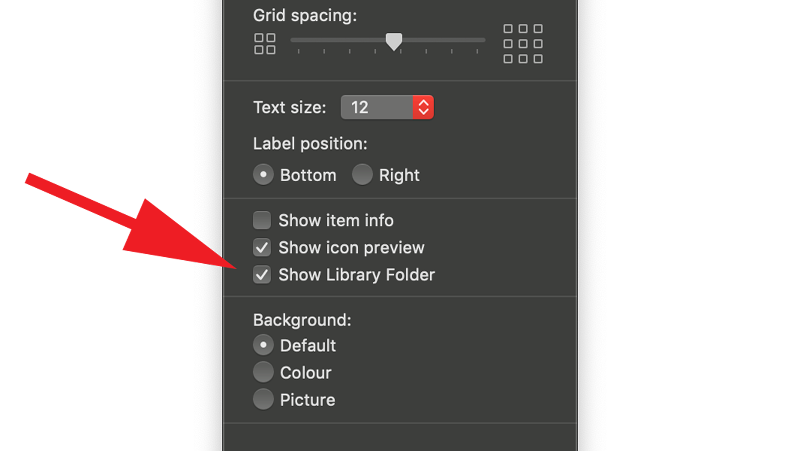
Now you’ll able to open the folder and look for the files that you suspect are taking up room on your drive. There are actually multiple ways to make the hidden Library folder visible, read: how to show hidden files on Mac for more details about finding hidden files.
The important thing is to exercise caution and only delete things that you know are superfluous.
The best option in our opinion really is to use a dedicated optimisation utility, so take a look at our guide to the best Mac cleaner software and optimisation utilities as it provides the easiest method for keeping your Mac in tip-top condition. You can also reduce the amount of wasted storage on your device by following the tips in how to free up space on Mac.
When we wanted to recover storage space when we were attempting to install macOS Big Sur we relied on CleanMyMac X which has a tool for clearing System Junk. CleanMyMac X is £29.95/$29.95 right now if you buy the plan for one Mac. There is also a free trial. Download from developer MacPaw here.
